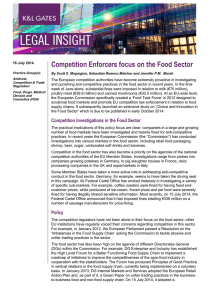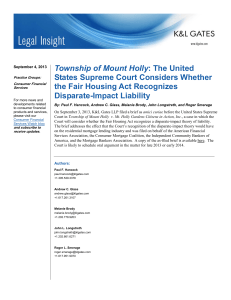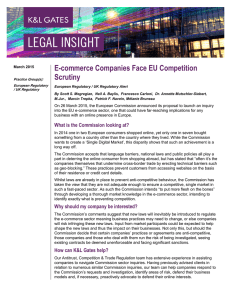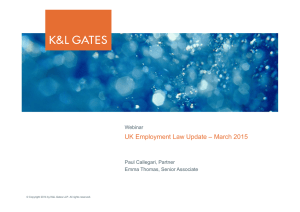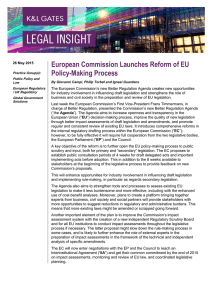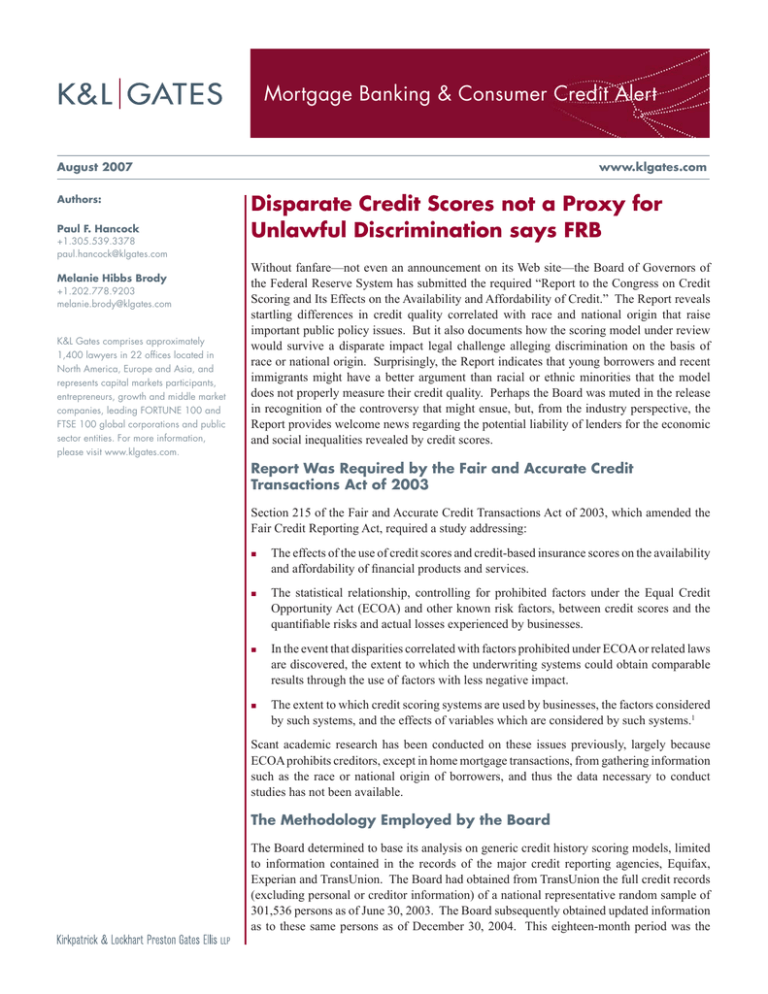
Mortgage Banking & Consumer Credit Alert
August 2007
Authors:
Paul F. Hancock
+1.305.539.3378
paul.hancock@klgates.com
Melanie Hibbs Brody
+1.202.778.9203
melanie.brody@klgates.com
K&L Gates comprises approximately
1,400 lawyers in 22 offices located in
North America, Europe and Asia, and
represents capital markets participants,
entrepreneurs, growth and middle market
companies, leading FORTUNE 100 and
FTSE 100 global corporations and public
sector entities. For more information,
please visit www.klgates.com.
www.klgates.com
Disparate Credit Scores not a Proxy for
Unlawful Discrimination says FRB
Without fanfare—not even an announcement on its Web site—the Board of Governors of
the Federal Reserve System has submitted the required “Report to the Congress on Credit
Scoring and Its Effects on the Availability and Affordability of Credit.” The Report reveals
startling differences in credit quality correlated with race and national origin that raise
important public policy issues. But it also documents how the scoring model under review
would survive a disparate impact legal challenge alleging discrimination on the basis of
race or national origin. Surprisingly, the Report indicates that young borrowers and recent
immigrants might have a better argument than racial or ethnic minorities that the model
does not properly measure their credit quality. Perhaps the Board was muted in the release
in recognition of the controversy that might ensue, but, from the industry perspective, the
Report provides welcome news regarding the potential liability of lenders for the economic
and social inequalities revealed by credit scores.
Report Was Required by the Fair and Accurate Credit
Transactions Act of 2003
Section 215 of the Fair and Accurate Credit Transactions Act of 2003, which amended the
Fair Credit Reporting Act, required a study addressing:
The effects of the use of credit scores and credit-based insurance scores on the availability
and affordability of financial products and services.
The statistical relationship, controlling for prohibited factors under the Equal Credit
Opportunity Act (ECOA) and other known risk factors, between credit scores and the
quantifiable risks and actual losses experienced by businesses.
In the event that disparities correlated with factors prohibited under ECOA or related laws
are discovered, the extent to which the underwriting systems could obtain comparable
results through the use of factors with less negative impact.
The extent to which credit scoring systems are used by businesses, the factors considered
by such systems, and the effects of variables which are considered by such systems.1
Scant academic research has been conducted on these issues previously, largely because
ECOA prohibits creditors, except in home mortgage transactions, from gathering information
such as the race or national origin of borrowers, and thus the data necessary to conduct
studies has not been available.
The Methodology Employed by the Board
The Board determined to base its analysis on generic credit history scoring models, limited
to information contained in the records of the major credit reporting agencies, Equifax,
Experian and TransUnion. The Board had obtained from TransUnion the full credit records
(excluding personal or creditor information) of a national representative random sample of
301,536 persons as of June 30, 2003. The Board subsequently obtained updated information
as to these same persons as of December 30, 2004. This eighteen-month period was the
Mortgage Banking & Consumer Credit Alert
time period for the study. TransUnion included
312 precalculated “credit characteristics” in the data.
TransUnion also provided two generic credit history
scores, the TransRisk Account Management Score
and the VantageScore, for each person in the sample.2
The Social Security Administration provided crucial
information necessary to conduct the study, such as
citizenship, race or ethnic description, sex and date of
birth for the persons in the sample. A demographic
information firm also provided data to the Board.
Although the Board had the scores and credit
characteristics collected by TransUnion, it apparently
did not have access to the proprietary model on which
the scores were based. Thus the Board determined
to develop its own model, referenced as the “FRB
base model.” “This model was used to investigate
whether the factors included in credit-scoring models
result in negative or differential effects on specific
subpopulations [such as racial or ethnic minorities]
and, if so, whether such effects could be mitigated by
changes in the model development process.” Report at
0-3. The Report notes that this model closely reflects
the methodologies used in the industry to develop
scoring models, but “it does not represent fully any
particular model in use today.” Id. at 0-10.
The performance period for the FRB base model
was the eighteen-month period for which data was
available, and the model was designed to predict
whether an individual would have one new or existing
account that would become seriously delinquent (such
as becoming 90 days or more past due) during the time
period. In an effort to replicate industry standards, the
model segments the sample population into different
“scorecards.” The Board used three scorecards: a
“thin file” scorecard for persons with relatively few
accounts; a “clean record” scorecard for persons with
no major derogatories; and a “major derogatory”
scorecard. The three scorecards consist of 19 credit
characteristics, drawn from the 312 provided by
TransUnion.3
The Report concedes that the FRB base model is only
an approximation and does not fully reflect industry
models. For example, industry models generally use a
larger number of scorecards, measure performance over
a longer period of time, and may define performance
terms differently. Nonetheless, the Report concludes
that the FRB base model displays predictiveness “that
is in line with other generic credit-scoring models that
use the same measure of performance for estimation.”
Id. at 78.4
Results of the Study
The Report traces the development of credit scoring
and extols its virtues in lowering the cost and
increasing the speed of the credit analysis process. The
distribution of credit scores across the population in
general has been available to the public for some time.
The groundbreaking portion of the Report, however, is
the portion that addresses the impact of credit scoring
on racial and ethnic minorities as well as on the young
and old and recent immigrants to the United States.
The Report concludes that the “[d]ifferences in credit
scores among racial and ethnic groups and age cohorts
are particularly large.” Id. at 80.
Score differences among subpopulations
Blacks and Hispanics, on average, have markedly
lower credit scores than Asians and non-Hispanic
Whites. To describe this impact, the Board normalized
the scores of persons in the sample such that a score of
50 places a person at the mean of the distribution. The
mean TransUnion score for Asians was reported to be
54.8; for non-Hispanic Whites, 54.0; for Hispanics,
38.2; and for Blacks, 25.6. From another perspective,
30.1 percent of the Hispanics, and 52.6 percent of the
Blacks in the sample, were in the lowest two score
deciles, as compared to only 16.3 percent of the
non-Hispanic Whites. Id. at 80. Differences correlated
with age also were observed. Persons under 30 had a
mean score of 34.3, and those 62 and older had a mean
score of 68.1. Id. at 81.5
The differences in credit scores between non-Hispanic
Whites, Blacks and Hispanics are narrowed, but not
eliminated, by controlling for factors such as income
estimation, location of residence, marital status and
age.
Although the Report describes the differences in
scores that are correlated with race and ethnicity, it
also concludes that “each of the three credit scores
used in this study predicts future loan performance”
(id. at 87), and the Report cites performance data to
support the conclusion.
August 2007 | 2
Mortgage Banking & Consumer Credit Alert
Divergence from performance
predicted by score
In addition to describing the score differences among
subpopulations, the Board concluded that some of
the subpopulations, on average, actually performed
better or worse than their credit score would indicate.
The Report finds that “blacks, single individuals,
individuals residing in lower-income or predominately
minority census tracts show consistently higher
incidences of bad performance than would be
predicted by the credit scores.” Id. at 89. On the
other hand, “Asians, married individuals, foreign born
(particularly recent immigrants), and those residing
in higher-income census tracts consistently perform
better than predicted by their credit scores.” Id.
Possible explanations for score
differences among subpopulations
The Board examined whether differences in
performance might be caused by loan terms provided
to minorities, but concluded that “differences in the
kind of loans used by different populations and the
interest rate paid do not appear to be the source of
differences in performance once credit score is taken
into account.” Id. at 94. The Report concedes that its
methodology may not properly capture the full price
of all loans, particularly variable-rate loans or loans
for which substantial fees were charged. The Board
also noted that “Black borrowers experienced higher
interest rates than non-Hispanic whites for each loan
category in which interest rates can be determined,
although . . . some differences were small.” Id. at 5.
The Board also described other factors, referenced
as “the five C’s,” that likely impact the differences
in credit performance correlated with factors such as
race, national origin, or age:
Capacity—Income flow to service debts.5
Capital—assets available to repay a loan.
Collateral—value of assets backing a loan.
Conditions—trigger events that may disrupt
income flow.
Character—financial experience, skills and
willingness to manage financial obligations.
Some might argue that our Nation’s long history of
discrimination against racial and ethnic minorities
causes lingering effects in each of “the five C’s,”
which, in turn, have obvious impact on credit scores
and credit performance.
Possible proxies for prohibited factors
The Board conducted extensive research in considering
whether the factors considered in credit scoring (i.e.,
the credit characteristics provided by TransUnion)
were mere proxies for race or national origin, or
whether they were necessary to accurately predict
performance. The Report concludes that “[f]or race
and ethnicity, almost all of the credit characteristics
. . . are more correlated with performance than with
demographic characteristic . . . regardless of the
specific group considered.” Report at 101. “Indeed,
most credit characteristics are only minimally
correlated with race and ethnicity, many are not
correlated at all, and none are highly correlated. . . .
[T]he characteristics that are most correlated with both
performance and race are all related to past payment
history. Each of these characteristics is also highly
correlated with performance.” Id. at 102.
The analysis of age led to a different conclusion. Many
characteristics are highly correlated with age, most of
which relate to the time factors, such as “length of
credit history.” These factors are also highly correlated
with the status of “recent immigrant,” inasmuch as
the factors affecting the young also impact recent
immigrants.
Consideration of options to lessen
impact on subpopulations
Even though the Board concluded that the credit
scoring models accurately predicted performance,
it also evaluated whether the predictiveness could
be retained with factors that might lessen the
impact on some subpopulations, such as Blacks and
Hispanics. For most subpopulations, dropping any
single characteristic had only a slight effect. The one
exception was that dropping “average age of accounts”
significantly raised the credit scores for young people
and recent immigrants.
In addition to considering dropping individual
characteristics, the Board considered the impact of
dropping groups of credit characteristics. Dropping
the group of characteristics related to payment history
caused an increase in the scores of Blacks. Dropping
the group related to “length of credit history” caused
August 2007 | 3
Mortgage Banking & Consumer Credit Alert
large changes in the scores by age and for recent
immigrants.
The Board further examined the impact of adding
other credit characteristics to the model, but found
little impact on credit scores across subpopulations.
“None of the additional credit characteristics changed
the mean credit score for blacks by more than 0.39
points.” Id. at 108.
The Board specifically considered the impact of adding
characteristics related to finance company trades,
inasmuch as this characteristic has been criticized as
possibly creating a racial bias.6 The conclusion was
that adding these factors had very minimal negative or
positive impact on the scores of Blacks.
Race- and age-neutral analyses
Adding and subtracting credit characteristics supported
the Board’s conclusion, but the Board determined that
the most academically accurate measure of the model
would be an evaluation under race-neutral and ageneutral models. Such tests were performed. “For the
racial assessment, the sample was restricted to nonHispanic whites (the “white only” model). For age,
the estimating sample was limited to individuals aged
40 or older (the “older age” models).” Id. at 110.
Another methodology used the entire sample, “but
in reestimating the attribute weights the estimations
include shifts in the racial intercept (the “racialindicator variable” model) or shifts in the age intercept
(the “age-indicator variable” model).”
These tests revealed “virtually no difference”
correlated with race. “[M]ean scores for blacks are
only 0.1 point higher for the white-only and racialindicator-variable models.” Id at 112.
“In contrast to race, it appears that mean credit scores
and performance residuals for recent immigrants
differ between the models estimated in a race neutral
environment and the FRB base model. Notably,
mean credit scores for recent immigrants are 0.3
point higher in the two racially neutral models, and
their overperformance declines also by about 0.3
percentage point.” Id. at 112.
Overall, the report concludes that “in the aggregate,
there is no differential effect for race or ethnicity in the
FRB base model.” However, “there is some evidence
that the FRB base model credit characteristics may
embed some disparate effects by age, but the effect
appears small.” Id. at 115. The effects are caused by
the same characteristics that impact recent immigrants,
“average age of accounts” and related characteristics.
At the same time, the Report notes that dropping
these characteristics from the model would negatively
impact its predictive value. Id. at 116.
The Board suggests that the scores of recent
immigrants might be made more consistent with
performance if nontraditional credit factors, such as
rent or utility payments, could be added to the credit
bureau records.
Legal Meaning of the Board’s
Findings
The Report does not declare a winner, but the factual
conclusions of the Board support a conclusion
that the FRB base model does not have an illegal
discriminatory impact that would violate ECOA or
the Fair Housing Act.
Most fair lending cases present claims of “disparate
treatment,” which is a form of intentional
discrimination. A more controversial legal theory
contends that even policies and practices that are
adopted and implemented without a discriminatory
purpose can be unlawful if they have a discriminatory
impact. A plaintiff can thus challenge a racially neutral
policy and, to support the claim, present statistical
evidence demonstrating that the policy detrimentally
impacts a significantly greater percentage of a
particular racial or ethnic group than it does Whites.
To avoid a finding of liability, the defendant can
show that, notwithstanding this differential impact,
the policy is based on sound business reasons or,
as sometimes is said, a “business necessity.” A
plaintiff can still prevail if she can demonstrate that
the business purpose can be achieved by policies that
have a significantly smaller differential impact.7
The Report subjects the FRB base model to this
disparate impact analysis. It concludes that the credit
scoring model results in significantly lower scores for
Blacks and Hispanics as compared to non-Hispanic
Whites. Thus, a plaintiff (if she had this data) may
satisfy the first step of the test. Young persons and
new immigrants similarly experience such impact.
The Board demonstrates, however, that the
characteristics of the model are not proxies for race
or national origin, but rather, accurately predict
August 2007 | 4
Mortgage Banking & Consumer Credit Alert
performance. In fact, the Board concludes that
Blacks are somewhat advantaged by the model in
that, on average, their relative performance is worse
than their score would predict. Lenders have a
legitimate business interest in having loans repaid,
and factors that accurately predict the likelihood of
repayment would most likely qualify as a legitimate
business justification or “business necessity.” The
Board further considered whether other factors might
satisfy the legitimate business interest but have less of
a differential impact, but could not identify any such
factor. Thus, in a legal challenge based on claims of
disparate impact on Blacks or Hispanics, the mythical
company using the FRB base model likely wins.
ECOA (but not the Fair Housing Act) also prohibits
discrimination on the basis of age, and a disparate
impact claim pursued by young borrowers might
require more analysis. Unlike the issue discussed
above, the Board concluded that young borrowers
actually perform better than their score would indicate.
But the factor that causes the differential impact upon
young borrowers (average age of account) also is
highly predictive of performance. Thus, the Report
may be read to establish the business justification for
the differential. The Board was not able to identify an
alternate characteristic that eliminated the differential
impact but preserved the business justification. Thus
again, the mythical company using the model would
likely prevail.8
The Impact of the Report
This Report likely will be the subject of fierce debate,
much like the FTC’s related study on credit-based
insurance scores or even the well-known study of
disparate treatment in underwriting conducted by the
Federal Reserve Bank of Boston in 1991. The Board
itself recognizes the limitations of the FRB base model,
and other academics and advocacy organizations may
have more critical comments. And, of course, the
model the Board developed has not been used by any
company, and whether the proprietary models used by
numerous lenders would fare as well under a disparate
impact analysis remains an open question.
TransRisk model and the VantageScore model. For
many years, raw HMDA data revealing racial and
ethnic disparities has caused a focus on the policies of
lenders. While that will not go away entirely by this
Report, the Report, for the first time, documents more
basic causes of the disparities. It will be important
for policymakers, such as the Congress to whom the
Report is addressed, to consider these underlying
issues in order to achieve equality in home ownership
and other financial opportunities.
The Report certainly will not be the final word on the
subject, but the industry could not have asked for a
better start. Since the beginning of the fair lending
enforcement program, lending industry leaders have
feared the application of the disparate impact legal
theory, largely because the differential impacts of
many lending policies were surmised, even if not
documented, and the burden that might be imposed to
justify the policies was unknown. At least as to this
model, however, the defendant wins, and a path has
been laid to defend challenges in the future.
Endnotes
1
The law assigned responsibility for conducting the study
to the Federal Trade Commission (FTC) and the Board, and
both agencies were required to consult with the Department of
Housing and Urban Development (HUD). The Board assumed
lead responsibility for assessing the effects of credit scoring on
credit markets. The FTC assumed lead responsibility in the area
of insurance and issued a report on the subject in July, 2007.
The FTC reached conclusions similar to those reached by the
Board as described in the text above, finding that “credit-based
insurance scores are effective predictors of risk under automobile
insurance policies . . . [including] within racial, ethnic, and
income groups.” See Credit-Based Insurance Scores: Impacts
on Consumers of Automobile Insurance, A Report to Congress
by the Federal Trade Commission (the “FTC study”), at 8283. In a July 24, 2007 press release, the Consumer Federation
of America, the Center for Economic Justice, the National
Consumer Law Center and the National Fair Housing Alliance
contended that the FTC study “is fatally flawed” and called on
Congress to reject the study and to ban the use of credit scoring
in insurance.
2
The Report, at the same time, presents important
public policy questions. The disparity in credit scores
correlated with race and national origin is revealed
not just by the FRB base model, but also by the
The TransRisk score is a propriety model of TransUnion.
The VantageScore was developed jointly by Equifax, Experian
and TransUnion and is designed to score persons consistently
across the three companies.
August 2007 | 5
Mortgage Banking & Consumer Credit Alert
3
The Report states:
The thin-file scorecard has eight credit characteristics
and includes 9.9 percent of the individuals in the
estimation sample. The clean-record scorecard has
eight credit characteristics and covers 58.9 percent
of the estimation sample. The major-derogatory
scorecard has 10 credit characteristics and includes
31.2 percent of the sample.
Id. at 76.
4
Only 7.3 percent of the persons in the “clean file” category
experienced bad performance, as compared to 34.8 percent of
the persons in the “thin file” category, and 64.7 percent of the
persons in the “major derogatory” category. Id. at 77.
5
The Report states that married persons scored higher than
singles, but that these scores vary little by gender. Differences
correlated with income, location of residence and other factors
are addressed in the Report but will not be discussed further in
this Alert.
6
The Report notes, for example, “for black families, mean
income in 2000 was $38,700; for non-Hispanic white families,
$56,870; and for Hispanic families, $42,800.” Id. at 99, n.128.
7
The inclusion of this characteristic in modeling has been
criticized because it causes a negative impact on a score even
if the finance account was paid in a timely manner. The Board
seems to conclude that this characteristic, although not included
in the FRB base model, would not have a discriminatory impact
if it had been used.
9
For an additional description of the disparate impact
legal theory and its applicability to lending, see K&L Gates
Mortgage Banking/Consumer Finance Commentary, “Loan
Eligibility Criteria Subject to Disparate Impact Attack” by
Paul F. Hancock, October 2006. Many courts have held that a
violation of the Fair Housing Act and ECOA can be established
under the disparate impact theory, but the issue has not yet been
addressed by the United States Supreme Court. Also, Section
805 of the Fair Housing Act, which prohibits certain types
of discrimination in mortgage lending, has not yet received
extensive judicial interpretation.
10
The Report also describes the differential effect of the model
on “recent immigrants.” Neither ECOA nor the Fair Housing
Act prohibits discrimination on the basis of “recent immigrant”
status and, thus, a claim alleging discrimination against “recent
immigrants” would likely fail at the starting gate. In certain
factual settings, however, the term “recent immigrants” may
correlate highly with a particular national origin, and a claim of
discrimination on the basis of national origin may be presented.
As described in the Report the differential effect experienced
by “recent immigrants” arises because they exhibit the same
traits as young borrowers. If a disparate impact claim could be
pursued, the final conclusion may require more analysis since
the Board suggests a method by which the legitimate business
justification can be satisfied by a less discriminatory alternative,
i.e., the use of nontraditional credit factors.
August 2007 | 6
Mortgage Banking & Consumer Credit Alert
K&L Gates’ Mortgage Banking & Consumer Finance practice provides a comprehensive range of transactional,
regulatory compliance, enforcement and litigation services to the lending and settlement service industry.
Our focus includes first- and subordinate-lien, open- and closed-end residential mortgage loans, as well as
multi-family and commercial mortgage loans. We also advise clients on direct and indirect automobile, and
manufactured housing finance relationships. In addition, we handle unsecured consumer and commercial
lending. In all areas, our practice includes traditional and e-commerce applications of current law governing
the fields of mortgage banking and consumer finance.
For more information, please contact one of the professionals listed below.
LAWYERS
Boston
R. Bruce Allensworth
Irene C. Freidel
Stephen E. Moore
Stanley V. Ragalevsky
Nadya N. Fitisenko
Brian M. Forbes
bruce.allensworth@klgates.com
irene.freidel@klgates.com
stephen.moore@klgates.com
stan.ragalevsky@klgates.com
nadya.fitsenko@klgates.com
brian.forbes@klgates.com
+1.617.261.3119
+1.617.951.9154
+1.617.951.9191
+1.617.951.9203
+1.617.261.3173
+1.617.261.3152
thomas.poletti@klgates.com
+1.310.552.5045
paul.hancock@klgates.com
+1.305.539.3378
elwood.collins@klgates.com
steve.epstein@klgates.com
drew.malakoff@klgates.com
tom.russler@klgates.com
+1.212.536.4005
+1.212.536.4830
+1.216.536.4034
+1.202.536.4068
jonathan.jaffe@klgates.com
erin.murphy@klgates.com
+1.415.249.1023
+1.415.249.1038
holly.towle@klgates.com
+1.206.370.8334
costas.avrakotos@klgates.com
melanie.brody@klgates.com
eric.edwardson@klgates.com
steven.kaplan@klgates.com
phillip.kardis@klgates.com
rebecca.laird@klgates.com
larry.platt@klgates.com
phil.schulman@klgates.com
john.steele@klgates.com
ira.tannenbaum@klgates.com
nanci.weissgold@klgates.com
david.beam@klgates.com
emily.booth@klgates.com
krista.cooley@klgates.com
david.gaston@klgates.com
+1.202.778.9075
+1.202.778.9203
+1.202.778.9387
+1.202.778.9204
+1.202.778.9401
+1.202.778.9038
+1.202.778.9034
+1.202.778.9027
+1.202.778.9489
+1.202.778.9350
+1.202.778.9314
+1.202.778.9026
+1.202.778.9112
+1.202.778.9257
+1.202.778.9061
Los Angeles
Thomas J. Poletti
Miami
Paul F. Hancock
New York
Elwood F. Collins
Steve H. Epstein
Drew A. Malakoff
Thomas C. Russler
San Francisco
Jonathan Jaffe
Erin Murphy
Seattle
Holly K. Towle
Washington, D.C.
Costas A. Avrakotos
Melanie Hibbs Brody
Eric J. Edwardson
Steven M. Kaplan
Phillip John Kardis II
Rebecca H. Laird
Laurence E. Platt
Phillip L. Schulman
H. John Steele
Ira L. Tannenbaum
Nanci L. Weissgold
David L. Beam
Emily J. Booth
Krista Cooley
David Keith Gaston
August 2007 | 7
Mortgage Banking & Consumer Credit Alert
Anthony C. Green
Laura A. Johnson
Kris D. Kully
David G. McDonough, Jr.
Lorna M. Neill
Staci P. Newman
Stephanie C. Robinson
Kerri M. Smith
Holly M. Spencer
Erin E. Troy
anthony.green@klgates.com
laura.johnson@klgates.com
kris.kully@klgates.com
david.mcdonough@klgates.com
lorna.neill@klgates.com
staci.newman@klgates.com
stephanie.robinson@klgates.com
kerri.smith@klgates.com
holly.spencer@klgates.com
erin.troy@klgates.com
+1.202.778.9893
+1.202.778.9249
+1.202.778.9301
+1.202.778.9207
+1.202.778.9216
+1.202.778.9452
+1.202.778.9856
+1.202.778.9445
+1.202.778.9853
+1.202.778.9384
stacey.riggin@klgates.com
+1.202.778.9202
DIRECTOR OF LICENSING
Washington, D.C.
Stacey L. Riggin
REGULATORY COMPLIANCE ANALYSTS
Washington, D.C.
Dameian L. Buncum
Nancy J. Butler
Teresa Diaz
Jennifer Early
Marguerite T. Frampton
Robin L. Gieseke
Angela M. Gonzalez
Joann Kim
Brenda R. Kittrell
Dana L. Lopez
Jeffrey Prost
dameian.buncum@klgates.com
nancy.butler@klgates.com
teresa.diaz@klgates.com
jennifer.early@klgates.com
marguerite.frampton@klgates.com
robin.gieseke@klgates.com
angela.gonzalez@klgates.com
joann.kim@klgates.com
brenda.kittrell@klgates.com
dana.lopez@klgates.com
jeffrey.prost@klgates.com
+1.202.778.9093
+1.202.778.9374
+1.202.778.9852
+1.202.778.9291
+1.202.778.9253
+1.202.778.9481
+1.202.778.9369
+1.202.778.9421
+1.202.778.9049
+1.202.778.9383
+1.202.778.9364
K&L Gates comprises multiple affiliated partnerships: a limited liability partnership with the full name Kirkpatrick & Lockhart Preston Gates Ellis
LLP qualified in Delaware and maintaining offices throughout the U.S., in Berlin, and in Beijing (Kirkpatrick & Lockhart Preston Gates Ellis LLP
Beijing Representative Office); a limited liability partnership (also named Kirkpatrick & Lockhart Preston Gates Ellis LLP) incorporated in England
and maintaining our London office; a Taiwan general partnership (Kirkpatrick & Lockhart Preston Gates Ellis) which practices from our Taipei
office; and a Hong Kong general partnership (Kirkpatrick & Lockhart Preston Gates Ellis, Solicitors) which practices from our Hong Kong office.
K&L Gates maintains appropriate registrations in the jurisdictions in which its offices are located. A list of the partners in each entity is available
for inspection at any K&L Gates office.
This publication/newsletter is for informational purposes and does not contain or convey legal advice. The information herein should not be used
or relied upon in regard to any particular facts or circumstances without first consulting a lawyer.
Data Protection Act 1998—We may contact you from time to time with information on Kirkpatrick & Lockhart Preston Gates Ellis LLP seminars
and with our regular newsletters, which may be of interest to you. We will not provide your details to any third parties. Please e-mail london@
klgates.com if you would prefer not to receive this information.
©1996-2007 Kirkpatrick & Lockhart Preston Gates Ellis LLP. All Rights Reserved.
August 2007 | 8

